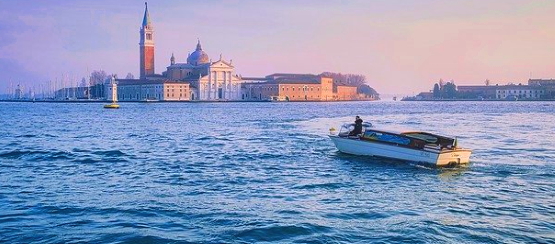|
Venice lagoon |
||||||
Insider tip: Travel comfortably without queues, buy tickets online beforehand:
|
A lagoon is a usually shallow body of water that is largely separated from the sea. The term lagoon is used in a similar way.
An area of about 550 kmē is largely separated from the sea by peninsulas of the mainland and by the elongated islands of Lido and Pellestrina. This area consists of water areas, islands and especially mudflats, areas that are sometimes covered with water and sometimes not.
The largest of the islands within the lagoon is the island with the city of Venice. Today, the other islands in the lagoon and parts of the nearby mainland also belong to the city of Venice. However, the old city island of Venice, the Centro Storico, is the real Venice. Other islands in the lagoon are, for example, the islands of Murano, Burano and Torcello, which are popular with tourists. The islands Lido and Pellestrina, on the other hand, separate the lagoon from the open Mediterranean Sea. One side of the two elongated islands borders on the lagoon, the other on the open Adriatic Sea. >>>> 3 island trip for just 20 Euro
There are three exits from the Venice lagoon. Between the mainland and the island of Lido, between the two islands of Lido and Pellestrina and between the islands of Lido and the mainland, the water of the lagoon is connected to the sea respectively.
In the northern Adriatic, unlike the rest of the Mediterranean, there are strong tides. Because the water in the lagoon is extremely shallow in most places, large parts of the Venice Lagoon are underwater at high tide and land areas at low tide. In recent centuries, however, many places have been dredged, primarily to create navigation channels for shipping.
Several rivers flow into the Venice lagoon. However, salt water also flows in from the Adriatic Sea. Thus, the lagoon consists of brackish water, a mixture of fresh water and salt water. Among other things, this makes the region a unique, ecologically valuable, landscape. In the north of the lagoon the water has a very low salt content, in the south around the city Chioggia a much higher one. The lagoon is extremely endangered. For centuries, some rivers that flowed into the water body have been diverted. Among other things, this tends to make the lagoon deeper and deeper. The island of Venice itself is also in danger of sinking, also for other reasons. In recent years, there is one of the largest construction projects in Europe in the lagoon, which was largely completed in 2020. All three exits of the lagoon are to be able to be closed by sluices in case of strong high water. This should enable the city of Venice, the old town and other islands, to be protected from flooding. The flood protection project is called M.O.S.E. and is ecologically very controversial. It is now completed in 2022, and the locks seem to be working. In the future, there could be no more extreme flooding in the old city of Venice. Probably no city in the world is or was more famous for floods than Venice. There are more than 100 islands in the lagoon. However, many are very small, only about 12 are inhabited (including the lagoon boundary islands of Lido and Pellestrina). The largest island is Centro Storico with the famous city of Venice. It is just over 5 kmē, or about 1% of the area of the entire 550 kmē lagoon. Cannaregio, the north of Venice
The water in the lagoon was very dirty for decades and had a bad smell. Especially by sewage such as the feces of the many people, industry and shipping, the lagoon was heavily polluted. This has improved somewhat. However, many more efforts and high investment are needed until one can speak of a largely clean body of water. |
|
||||


